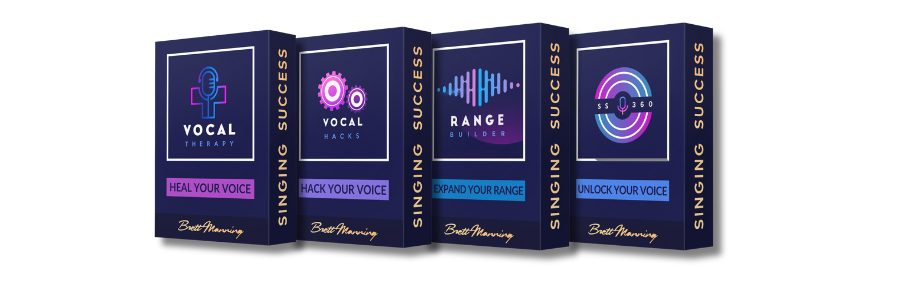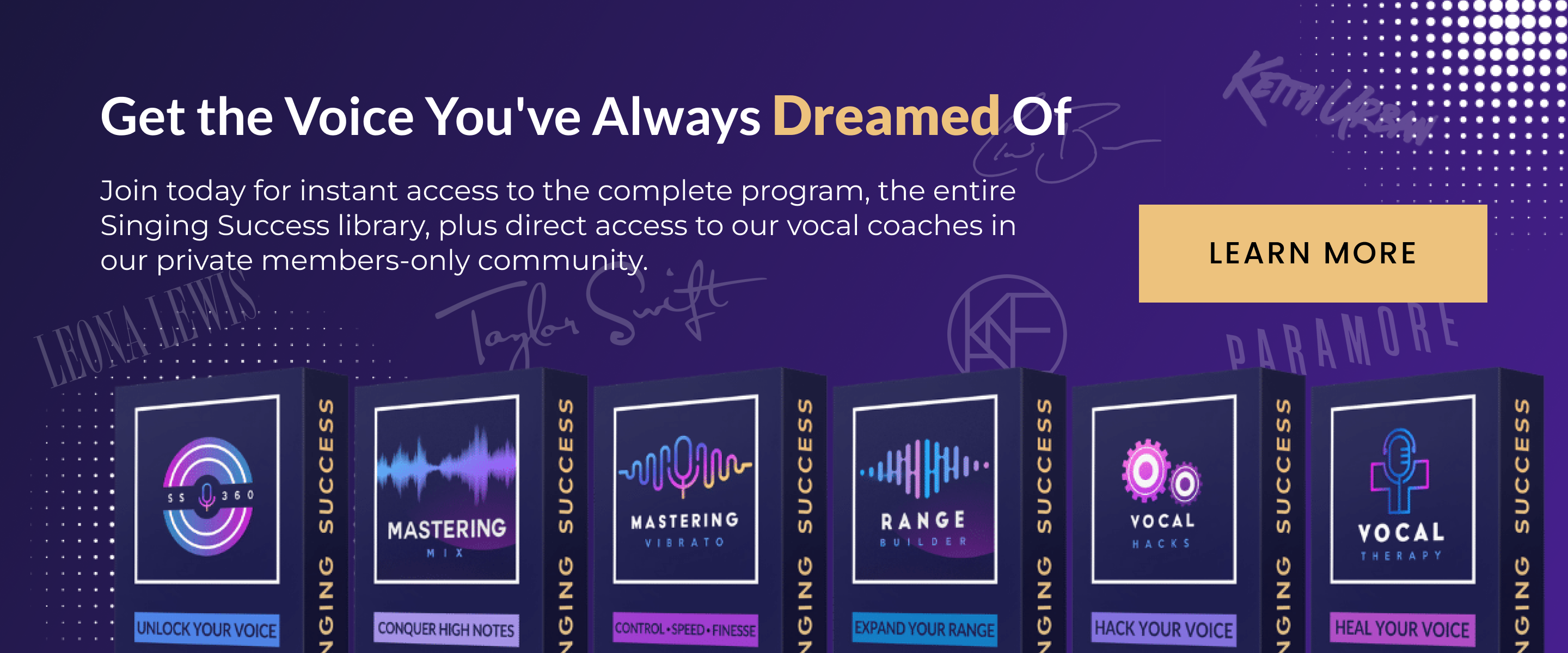“FREE BIRD! FREE BIRD! FREE BIRD” the typical audience members shouted longingly and some shouted mockingly.
“Sweet Caroline! Wonderwall! Margaritaville! Superstitious! Baby Got back! Piano Man! Don’t Stop Believing! Friends in Low Places! Living on a Prayer! Fight for Your Right to Party! Old Time Rock and Roll! Sweet Home Alabama!” and other audience requests.
The band often thinks “Man, I’ve played this song 2804 times….if I play it one more time it will kill me” or “Why not…. it’s a paycheck?” or “YES…. I get better with age!”
Fast-Track Your Success!!

VIP Membership includes:
- Exclusive Facebook Group
- Interact with our vocal coaches–ask them YOUR question
- Live warmups
- Masterclasses and Q&As with Brett Manning and his guests
- SS360 QuickStart Program
- SS360 – The FULL Systematic Vocal Course
- Vocal Hacks
- Range Builder
- Mastering Mix
- Mastering Harmony
- Mastering Vibrato
- Vocal Therapy
- Plus…exclusive content only found here all along the way!
You can struggle on your own, or you can get direct access to the Nashville Coaches who have launched some of the biggest names in the music industry.
And what about Christmas with the following covers we hear every year until our ears are numb and the words and melodies are blurred?….
- All I Want for Christmas is You
- The Christmas Song (Chestnuts roasting on an open fire)
- O Holy Night
- Silent Night
- What Child is This?
- Santa Claus is Coming to Town
- Breath of Heaven
- Mary, Did You Know (For the record…. she knew. An angel told her 😉 😎 😂)
- White Christmas

And on and on. Almost nothing is trickier than choosing a Christmas song. People are sick of everyone’s zealous promotion of their new project of old songs. They’re tired of hearing the same old song over and over again.
However…….keep listening. Some folks really and truly love to hear the same songs over and over.
But there’s examples of legends who continued to bring magic, charm, swagger, fresh perspective and legendary performances with their old songs….. even after 50 years! Consider the original writer of “The Christmas Song,” the late great artist, Mel Torme!
Take a listen to his two performances of “The Christmas Song,” co-written by Mel Torme (when he was only 19) in 1945. It was first recorded by Nat King Cole in 1946 and it was an instant hit.
Years later, Mel Torme recorded his version in 1955 and it was and still is a masterpiece.
Over 50 years after recording this classic—and no doubt, having performed this song 1000’s of times as well as hearing the 100’s of renditions by other recording artists—Mel performed The Christmas Song live in the 1990’s, while in his 70’s.
Imagine singing a song the first time when you’re only 19, then hearing it blare across the radio several times a day in every department store, restaurant and house party throughout the entire month of November!
And yet…..
MEL SANG IT BETTER….LIKE HE’D BARELY JUST WRITTEN IT!!!
In this article, I’m going to explain how to do this for all of us musicians out there who get tired of playing the same songs over and over!
Sure! You’re bored. You hate the biggest hits and you just know that non musicians can relate or feel your pain, right?
You and every musician I know, rightfully worry that the crowd can sense that you don’t enjoy playing the same songs anymore!
I’ll explain how legendary tunes can still be fun to perform and how to create a moment in a live show. And, we will discuss how to make people react as if this sound you’re playing is like a new song in ALL your live performances…. no matter how many times you play.
All artists reluctantly concede to playing the same songs eventually. But, the crowd is there to watch you and ISN’T tired of you playing the same songs, because they listen to 1000’s of artists throughout their lifetime. You mostly only listen to yourself….if you’re practicing and performing all the time.
As a singer or musician in a band, you can grow tired of playing your “old material” and performing can sometimes feel repetitive and monotonous! However, there are strategies you can use to keep your performances fresh and engaging, no matter how many times you’ve sung the same song.
*In this article, we’ll explore how to reinvent, rearrange, and embrace the song, discover new meanings, experiment with different interpretations, and incorporate other songs into your performance. By keeping these tips in mind, you’ll stay feeling new and excited every time you perform.
Embrace the Song
Every tune you perform should have something personal that makes you love the song more every day. If you HATE your #1 hit, but your audience LOVES it, you’re obligated. So learn to keep loving the thing you stopped loving. Your fans should come first! Otherwise, forget the stage and play in your bedroom for yourself. (Please don’t read a harsh tone in this. I’m speaking realistically.)
To never get tired of singing the same ole song, it’s important to embrace it and find joy in performing it. This can be done by:
- Connecting with the lyric emotionally and mentally.
- Finding personal meaning in the lyric.
- Reflecting on past performances that were particularly memorable.
- Developing a personal connection with the song, resulting in an improved performance, keeping it feeling fresh and exciting.
Understanding the Message of the ‘Same Ole Song’
In my course,Singing Success 360, I describe the process of interpreting lyrics with first providing this definition:
Interpret: bringing to light the intention of the author.
This is done through asking HOW and the 5 W’s: who, what, when, where, and why.
Ask the lyric these 6 questions and you’ll rarely get tired of playing or performing the same set of tunes. Here’s an example from one of my own recordings:
“WHAT IF I HAD DRIVEN ‘ROUND THE BLOCK…. JUST TO WASTE A COUPLE TICKS ON THE CLOCK”
“WHAT IF I DECIDED NOT TO STOP….YOU WOULD HAVE NEVER ENTERED MY THOUGHTS”
Ask who is singing and who am I talking about? What am I talking about? What time of of the day is it…. meaning…. when was I driving around the block, time of day, month and year? Where am I driving, what kind of car am I driving, why did I stop and why am I asking the question “What if I?“
How am I going to answer you and how do I want you to feel about this? More specifics later on, in this article!
If you can see a music video in your mind, every sentence you sing will be a scene in that video. Singers and musicians only get bored when the forget to imagine themselves as part of the music.
If you’re chatting about trees, cars, buildings, parks, lovers or any images that conjure emotions, you need to make then SEE. If you’re bored, they will be bored! You have the power to lead your fans to see what you sing. You want them to wake up and say “I’ve heard this song 1000x, but the band and the singer opened a whole new world to me last night! I feel like I’ve just heard or “seen” the song for the first time last night.

Imagine seeing this in your mind while singing. The impact will shake up their world and yours! Emotions have to be playing through you to them!
Discovering New Meanings in the Same Song
Each time you prepare to sing, ask yourself:
“What do the words mean…………..today?”
Let me give you an extreme example from a personal experience. Honestly, this is so personal that I don’t want to share it…. but I will because that’s what being an artist is all about, right? Vulnerability!
In 2008 my oldest brother—at the age 49—was in the hospice fading fast. We had already conceded that he was going to pass and so my mother called urgently asking if I could sing “Amazing Grace” over the speaker phone.
My heartbeat raced to double speed and I agreed and then this happened….a singer I don’t know showed up. I wasn’t performing. I was comforting my brother and everyone in the other room who could hear my ‘rendition’ of this timeless tune was trembling.
Someone said to me afterwards…. “So that’s what singing is for!”
Yes! You could spend your whole life trying to figure out who you are as a musician/artist and then one experience singing to a sick or dying friend or relative… or even a stranger…. can change everything!
“Amazing Grace” doesn’t feel boring anymore and will always elicit more from me than I could naturally produce.

Experiment with Different Interpretations
Many artists rarely admit they are tired of playing the same tune over and over. But the demand for new material is more in their own head than their fans. Especially non musicians. This fan group wants a to hear your music because they’ve listened to your recordings repeatedly.
But you can take an existing fan favorite and rearrange it the following ways:
- Take a ballad and speed it up to give it new life.
- Slow down an uptempo song and move over from electric guitars to the piano.
- Sing in a total different key.
- Invite another artist to come up and perform it as a duet.
- Let the band go off on a jam session in the middle of the bridge.
- Do a mash up on a ‘biggest hits night’ and don’t worry if they happen to be covers. Most artists don’t have any hits yet.
- Incorporate other styles. Make it more bluesy, soulful, country, more rock or be like Muse who puts a Rachmaninoff solo in the bridge.
- Pick an alternative high note at the end of the song.
- Add crazy stuff to your stage like an odd looking, antique stool that you sit on to sing a ballad.
- Try hiring a light show expert and make sure you and all the musicians communicate with him or her to bring up the lights strategically to highlight each of the musicians, especially if they play a solo.
- Act like a true professional singer and decide you belong on stage and you won’t get tired of playing. Remember, you play guitar, play piano, play drums etc…so you should play your voice. Performing should be fun. If it’s fun for the musicians, it’s fun for the artists and, most of all, the audience.
Adding Your Own Flair to the Song
Artists, whether they are in bands or solo, will admit they get tired of playing the same tune every night. But there’s something else they are overlooking….
What about your own flair? Artists who are musicians, play with passion. But musicians who are not artists, lose their love of the stage.
Your own flair may mean changing up your image or style with yourself in order to match it up with your tune. Having personality means the way you look as much as the way you sound. Don’t be afraid to take chances. But get feedback from an experience vocal coach, manager or friends who are objective to make sure it’s YOUR OWN style and not a carbon copy of artists and musicians who already have their flair or image.
For example, don’t put fringe on your microphone stand like Steven Tyler of Aerosmith. You can decorate it. But don’t steal. Rather be inspired to play on stage and be playful about the phrasing, quirks and other stuff you want to add to your set. Copying other bands will get you called out quick and it will be embarrassing. Being inspired by other musicians is fine!

Incorporate Other Songs
The flow of your set list can be an instant difference maker. This is why I’ve recommended the great live show producer Tom Jackson to so many recording artists.
In fact, once during a breakthrough lesson with Taylor Swift (Just after she hit a bunch of epic Mariah Carey notes 😲 …seriously!), I called up Tom and introduced him to Taylor. Their working together had been historical!
Tom has a gift of creating moments in a performance by working with the musicians to change up the set list to give a more transcendent flow to the show. He’s the best I’ve ever seen and this is why I nearly always hire him for any boot camps for vocal retreats I’ve had. And he’s been gracious to have me teach voice at his bootcamps.
Check him out here ➡️ Tom Jackson Go to the top of the food chain! He’s the best!!
Weaving In Other Songs to Complement the Same Song
Weaving other songs into your performance to complement the same song is another way to keep your fans interested.
Creating seamless transitions between songs will build a cohesive setlist. An example of this how this can add depth and meaning to your performance, is in the following Queen songs:
These two anthems flow emotionally and lyrically. All musicians get it. The adrenaline of the simplest, yet most exciting and recognizable 3 beats: boom, boom, clap (rest) has become a theme for nearly every sports arena around the world. Followed by the anthem of all champions, this is an illustration of different keys, chord and tempos that belong together. In fact, growing up, I always heard these songs played as one song on the radio.
Just imagine your hits played fresh in every arena around the world. NO ONE grows tired of “We are the Champions” and “We will Rock You.” Even after nearly 5 decades of popularity.
Mashing Up the Same Song with Other Music Genres
As mentioned earlier, Mashups are a great way to supercharge a tune.
There is diverse, endless creative potential of mashing up with other music genres. An example could be a bluegrass/country tune mashed up with a bluesy rock hit. Make sure you either pick 2 songs with the same key or transpose one of the songs into a matching key with the other song.
Additionally, many songs use the same chord progressions and this is usually how songs are matched. Here’s 3 songs with the same chords, feel and almost identical melodies. I’m surprised earlier writers didn’t sue the others for copyright infringement. Anyway>>>
- Louie, Louie,
- Summer Lovin,
- Wild Thing
- ????
You can do a Google search for songs using the same chord progressions. Changing keys to match them is acceptable as long as the melody doesn’t somehow fit strangely different in the chord progressions causing you to suddenly raise up to high or drop too low melodically.
Examples:
C- G- am- F. [repeat]
or
C – am- F- G [repeat]
or
am- C- F- G [repeat]
These are the 3 most popular pop chord progressions and there’s literally 10’s of 1000’s of songs with these cords. Try to find songs than naturally flow together. But also take chances. Sometimes you spell relief “R-I-S-K.”
Write Your Own Music
If you’re a real musician or even “up and coming,” songwriting will give you the opportunity to showcase your unique style and creativity. When you’re writing your own music, you feel more emotionally invested in your art.
If you become a VIP Member with Singing Success, you’ll be in a caring and encouraging community of singers—many of them songwriters—who will connect with you and be willing to do co-writes.
If you’ve NEVER written one melody in your entire life, get with someone who has and learn by doing. Write down easy topics you believe will be helpful to express yourself.
A very quick songwriting hack is to copy a song you like but change the lyrics slightly and create your own melody over the same chords. The style section of Singing Success 360 can be of great help with this, particularly the practice of improvisation in Style Lesson 6.
Also, I’ve personally mentored 100’s of singers who’d never written a single song until they went through the writing process with me. Many of my coaches possess this same talent, so contacting my studio is a great way to get started!

Incorporating Your Original Songs into Your Set
Let me share some benefits of incorporating your own songs into your set with the same song, offer advice on selecting the right songs to complement the song and on creating a setlist that flows smoothly. Plus, I will provide examples of how incorporating your original songs can keep your performance feeling fresh and interesting.
First, when selecting the right songs, focus on finding pieces that complement the song in terms of theme, mood, or style. When creating a setlist, think about how you can weave your own songs into the performance to keep it feeling fresh and interesting. Incorporating your own songs into your set with the same song gives you the opportunity to showcase your range and versatility as a singer. By incorporating your own material, you can show your audience your unique artistry, while still honoring the original message and intention of the same song.
Embracing the Magic of Music
Embracing the magic of music in your performance shows them that you feel adrenaline and excitement every time you have to honor of performing. The more knowledge you have about the foundations of HOW music works, the more you—and the other musicians in your band—can keep songs fresh. Music is the most powerful and universal language. Those who communicate the most profoundly, lead the industry.
This means that you AND the musicians in your band work the audience, looking at certain individuals who appear friendly or even adoring fans. Then you can…..
Embrace the Energy of Audience
I remember doing a song called “The One” which was written about someone I no longer had romantic interest in or any relation. But I saw couples holding hands, embracing and looking longingly at each other while I sang.
Watching people get moved by your voice makes a few things happen— the musicians get instantly more expressive and delivery becomes more believable!
To this day, I’ve had random folks tell me that watching me sing “The One” was life changing. So…. HOW can I ever get tired?

Conclusion
So it turns out that knowledge really is power. Our brains aren’t merely mathematical bean counters, used to collect raw facts and data. Emotions come from thoughts and are communicated throughout the body.
It’s important to realize that your practice does NOT make perfect. Practice makes permanent. Make sure you get the best coaching, the best course, the best and most effective methods.
I proudly and happily recommend my mega talented coaches and best selling Singing Success courses.
visit us at
Or call our studios today at 615-866-1099.






